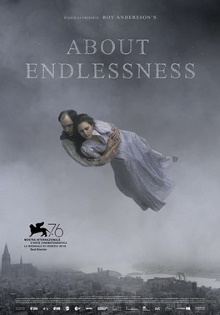If the strange poster which is also the film’s opening shot isn’t enough to clue you in, this is one very odd film, more like an art installation than any kind of narrative film. Apparently director Roy Andersson has made a whole career out of similar projects but this is my first experience of his work. It consists of long series of vignettes shot with a mostly motionless camera, most of which aren’t unconnected to anything else. It reminds me of Abbas Kiarostami’s 24 Frames in that regard but the intent and the effect is completely different.
There are dozens of these vignettes in what is already a rather short film. In most of them an unseen narrator describes what it is that we are seeing, for example, saying that this is a woman who is incapable of feeling shame. There are only a couple of recurring narratives. In one, a man recognizes an old friend on the street but the other man doesn’t acknowledge him. In another a priest has nightmares about being crucified. We later see that he is having a crisis of faith and seeks help from a psychiatrist. In most of the vignettes however there is no story at all, they are simply portrayals of a situation or perhaps a state of mind. In one a man stumbles into a diner and seeing a woman sitting alone at a table and asks if she is a certain name. She says not and soon afterwards a man arrives carrying drinks and the first man hurriedly backs off. I interpret that as being a portrait of embarrassment. Pretty much all of the vignettes depict dark and morbid situations and emotions. The only positive one I think is where a bunch of people are sitting silently at a cafe next to a path and a group of girls arrive and dance to a song, lightening up the whole scene.
The composition of each scene is naturally exquisite and uses a focus so sharp that you can practically see every grain of sand in the shot. Unlike 24 Frames, every vignette features human subjects, yet there is far less in the way of narrative here. It’s tempting to overinterpret and try to imagine a before and an after to what we see but I believe that it isn’t the intent here and we are meant to just take in the moment as we see it. While there is some variety of situations and emotions, the overwhelming sense that I get from them is apathy. In scene after scene, we see bystanders and background characters who merely sit or go about their business silently and without any animation whatsoever. Even when something shocking happens, the people respond hesitantly and warily, as if being reluctant to commit themselves to actions that are outside of their normal routines or to even feel something that would upset their internal balance. This makes it a vaguely depressing work of art to experience, yet by design it is not an especially intense or overpowering effect.
At the same time I detect a very European identity in this series of vignettes. That’s not unexpected of course but it’s still striking how specifically this is aimed at the European psyche. The questionable decision to include a scene about Adolf Hitler in his bunker reacting to the combat raging aboveground rather reinforces this point. So is the sight of a defeated army trudging through the wastes of Siberia and of course the story of the priest who has lost his faith. Some of the setups are more universal of course, such as the woman who has some trouble with her shoes while shopping and so sits down to take them off and then goes on as if nothing ever happened, while a man looks on. But I believe that the intent here is to create a work of art that reaches out to Europeans specifically to elicit an instinctive reaction. For myself while I can just about understand the intent behind each vignette if I stop to think about them for a while, the emotional reaction is more muted. I like this film well enough but it doesn’t immediately blow me away like 24 Frames did.
Andersson is a highly respectable filmmaker and usually that makes me feel like I’m obligated to experience more of his work. But from what I can tell, almost all of his body of work is like this, consisting of short vignettes with heavy symbolism and a very European character. As much as I admire this kind of work in the abstract, it’s hard to muster up much enthusiasm for actually watching it.
